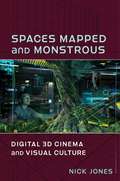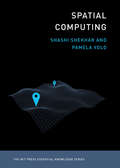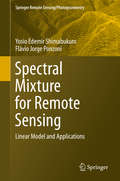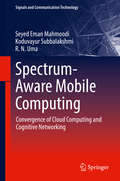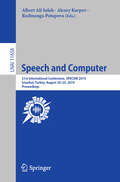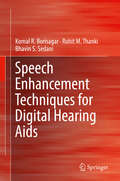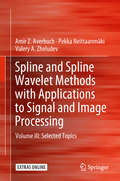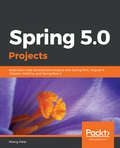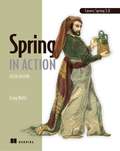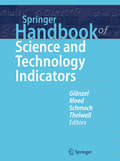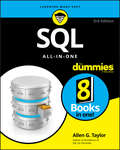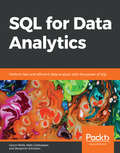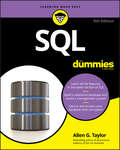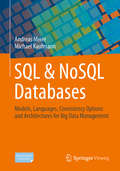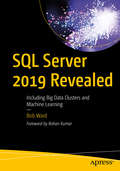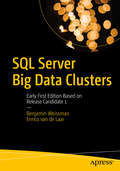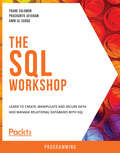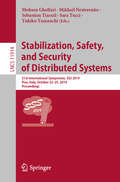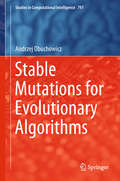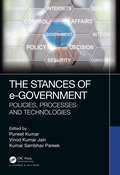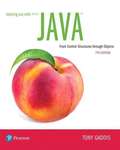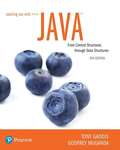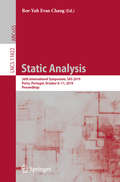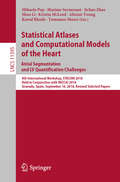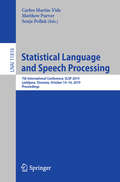- Table View
- List View
Spaces Mapped and Monstrous: Digital 3D Cinema and Visual Culture (Film and Culture Series)
by Nick JonesDigital 3D has become a core feature of the twenty-first-century visual landscape. Yet 3D cinema is a contradictory media form: producing spaces that are highly regimented and exhaustively detailed, it simultaneously relies upon distortions of vision and space that are inherently strange.Spaces Mapped and Monstrous explores the paradoxical nature of 3D cinema to offer a critical analysis of an inescapable part of contemporary culture. Considering 3D’s distinctive visual qualities and its connections to wider digital systems, Nick Jones situates the production and exhibition of 3D cinema within a web of aesthetic, technological, and historical contexts. He examines 3D’s relationship with computer interfaces, virtual reality, and digital networks as well as tracing its lineage to predigital models of visual organization. Jones emphasizes that 3D is not only a technology used in films but also a tool for producing, controlling, and distorting space within systems of surveillance, corporatization, and militarization. The book features detailed analysis of a wide range of films—including Avatar (2009), Goodbye to Language (2014), Love (2015), and Clash of the Titans (2010)—demonstrating that 3D is not merely an augmentation of 2D cinema but that it has its own unique properties. Spaces Mapped and Monstrous brings together media archaeology, digital theory, and textual analysis to provide a new account of the importance of 3D to visual culture today.
Spatial Computing (The MIT Press Essential Knowledge Series)
by Shashi Shekhar Pamela VoldAn accessible guide to the ideas and technologies underlying such applications as GPS, Google Maps, Pokémon Go, ride-sharing, driverless cars, and drone surveillance. Billions of people around the globe use various applications of spatial computing daily—by using a ride-sharing app, GPS, the e911 system, social media check-ins, even Pokémon Go. Scientists and researchers use spatial computing to track diseases, map the bottom of the oceans, chart the behavior of endangered species, and create election maps in real time. Drones and driverless cars use a variety of spatial computing technologies. Spatial computing works by understanding the physical world, knowing and communicating our relation to places in that world, and navigating through those places. It has changed our lives and infrastructures profoundly, marking a significant shift in how we make our way in the world. This volume in the MIT Essential Knowledge series explains the technologies and ideas behind spatial computing.The book offers accessible descriptions of GPS and location-based services, including the use of Wi-Fi, Bluetooth, and RFID for position determination out of satellite range; remote sensing, which uses satellite and aerial platforms to monitor such varied phenomena as global food production, the effects of climate change, and subsurface natural resources on other planets; geographic information systems (GIS), which store, analyze, and visualize spatial data; spatial databases, which store multiple forms of spatial data; and spatial statistics and spatial data science, used to analyze location-related data.
Spectral Mixture for Remote Sensing: Linear Model and Applications (Springer Remote Sensing/Photogrammetry)
by Yosio Edemir Shimabukuro Flávio Jorge PonzoniThis book explains in a didactic way the basic concepts of spectral mixing, digital numbers and orbital sensors, and then presents the linear modelling technique of spectral mixing and the generation of fractional images. In addition to presenting a theoretical basis for spectral mixing, the book provides examples of practical applications such as projects for estimating and monitoring deforested areas in the Amazon. In its seven chapters, the book offers remote sensing techniques to understand the main concepts, methods, and limitations of spectral mixing for digital image processing. Chapter 1 addresses the basic concepts of spectral mixing, while chapters 2 and 3 discuss digital numbers and orbital sensors such as MODIS and Landsat MSS. Chapter 4 details the linear spectral mixing model, and chapter 5 talks about how to use this technique to create fraction images. Chapter 6 offers remote sensing applications of fraction images in deforestation monitoring, burned-area mapping, selective logging detection, and land-use/land-cover mapping. Chapter 7 gives some concluding thoughts on spectral mixing, and considers future uses in environmental remote sensing. This book will be of interest to students, teachers, and researchers using remote sensing for Earth observation and environmental modelling.
Spectrum-Aware Mobile Computing: Convergence of Cloud Computing and Cognitive Networking (Signals and Communication Technology)
by Seyed Eman Mahmoodi Koduvayur Subbalakshmi R. N. UmaThis book presents solutions to the problems arising in two trends in mobile computing and their intersection: increased mobile traffic driven mainly by sophisticated smart phone applications; and the issue of user demand for lighter phones, which cause more battery power constrained handhelds to offload computations to resource intensive clouds (the second trend exacerbating the bandwidth crunch often experienced over wireless networks). The authors posit a new solution called spectrum aware cognitive mobile computing, which uses dynamic spectrum access and management concepts from wireless networking to offer overall optimized computation offloading and scheduling solutions that achieve optimal trade-offs between the mobile device and wireless resources. They show how in order to allow these competing goals to meet in the middle, and to meet the promise of 5G mobile computing, it is essential to consider mobile offloading holistically, from end to end and use the power of multi-radio access technologies that have been recently developed. Technologies covered in this book have applications to mobile computing, edge computing, fog computing, vehicular communications, mobile healthcare, mobile application developments such as augmented reality, and virtual reality.
Speech and Computer: 21st International Conference, SPECOM 2019, Istanbul, Turkey, August 20–25, 2019, Proceedings (Lecture Notes in Computer Science #11658)
by Albert Ali Salah Alexey Karpov Rodmonga PotapovaThis book constitutes the proceedings of the 21st International Conference on Speech and Computer, SPECOM 2019, held in Istanbul, Turkey, in August 2019.The 57 papers presented were carefully reviewed and selected from 86 submissions. The papers present current research in the area of computer speech processing including audio signal processing, automatic speech recognition, speaker recognition, computational paralinguistics, speech synthesis, sign language and multimodal processing, and speech and language resources.
Speech Enhancement Techniques for Digital Hearing Aids
by Komal R. Borisagar Rohit M. Thanki Bhavin S. SedaniThis book provides various speech enhancement algorithms for digital hearing aids. It covers information on noise signals extracted from silences of speech signal. The description of the algorithm used for this purpose is also provided. Different types of adaptive filters such as Least Mean Squares (LMS), Normalized LMS (NLMS) and Recursive Lease Squares (RLS) are described for noise reduction in the speech signals. Different types of noises are taken to generate noisy speech signals, and therefore information on various noises signals is provided. The comparative performance of various adaptive filters for noise reduction in speech signals is also described. In addition, the book provides a speech enhancement technique using adaptive filtering and necessary frequency strength enhancement using wavelet transform as per the requirement of audiogram for digital hearing aids.Presents speech enhancement techniques for improving performance of digital hearing aids;Covers various types of adaptive filters and their advantages and limitations;Provides a hybrid speech enhancement technique using wavelet transform and adaptive filters.
Spline and Spline Wavelet Methods with Applications to Signal and Image Processing: Volume III: Selected Topics
by Amir Z. Averbuch Pekka Neittaanmäki Valery A. ZheludevThis book provides a practical guide, complete with accompanying Matlab software, to many different types of polynomial and discrete splines and spline-based wavelets, multiwavelets and wavelet frames in signal and image processing applications. In self-contained form, it briefly outlines a broad range of polynomial and discrete splines with equidistant nodes and their signal-processing-relevant properties. In particular, interpolating, smoothing, and shift-orthogonal splines are presented.
Spring 5.0 Blueprints
by Nilang PatelThis book is for competent Spring developers who wish to understand how to develop complex yet flexible applications with Spring. You must have a good knowledge of Java programming and be familiar with the basics of Spring.
Spring in Action
by Craig WallsSummarySpring in Action, 5th Edition is the fully updated revision of Manning's bestselling Spring in Action. This new edition includes all Spring 5.0 updates, along with new examples on reactive programming, Spring WebFlux, and microservices. You'll also find the latest Spring best practices, including Spring Boot for application setup and configuration.Purchase of the print book includes a free eBook in PDF, Kindle, and ePub formats from Manning Publications.About the TechnologySpring Framework makes life easier for Java developers. New features in Spring 5 bring its productivity-focused approach to microservices, reactive development, and other modern application designs. With Spring Boot now fully integrated, you can start even complex projects with minimal configuration code. And the upgraded WebFlux framework supports reactive apps right out of the box!About the BookSpring in Action, 5th Edition guides you through Spring's core features, explained in Craig Walls' famously clear style. You'll roll up your sleeves and build a secure database-backed web app step by step. Along the way, you'll explore reactive programming, microservices, service discovery, RESTful APIs, deployment, and expert best practices. Whether you're just discovering Spring or leveling up to Spring 5.0, this Manning classic is your ticket!What's insideBuilding reactive applicationsSpring MVC for web apps and RESTful web servicesSecuring applications with Spring SecurityCovers Spring 5.0Over 100,000 copies sold!About the ReaderFor intermediate Java developers.About the AuthorCraig Walls is a principal software engineer at Pivotal, a popular author, an enthusiastic supporter of Spring Framework, and a frequent conference speaker.Table of ContentsPART 1 - FOUNDATIONAL SPRING Getting started with Spring Developing web applications Working with data Securing Spring Working with configuration properties PART 2 - INTEGRATED SPRINGCreating REST services Consuming REST services Sending messages asynchronously Integrating Spring PART 3 - REACTIVE SPRING Introducing Reactor Developing reactive APIs Persisting data reactivelyPART 4 CLOUD-NATIVE SPRINGDiscovering services Managing configuration Handling failure and latency PART 5 - DEPLOYED SPRING Working with Spring Boot Actuator Administering Spring Monitoring Spring with JMX Deploying Spring
Springer Handbook of Science and Technology Indicators (Springer Handbooks)
by Wolfgang Glänzel Henk F. Moed Ulrich Schmoch Mike ThelwallThis handbook presents the state of the art of quantitative methods and models to understand and assess the science and technology system. Focusing on various aspects of the development and application of indicators derived from data on scholarly publications, patents and electronic communications, the individual chapters, written by leading experts, discuss theoretical and methodological issues, illustrate applications, highlight their policy context and relevance, and point to future research directions.A substantial portion of the book is dedicated to detailed descriptions and analyses of data sources, presenting both traditional and advanced approaches. It addresses the main bibliographic metrics and indexes, such as the journal impact factor and the h-index, as well as altmetric and webometric indicators and science mapping techniques on different levels of aggregation and in the context of their value for the assessment of research performance as well as their impact on research policy and society. It also presents and critically discusses various national research evaluation systems.Complementing the sections reflecting on the science system, the technology section includes multiple chapters that explain different aspects of patent statistics, patent classification and database search methods to retrieve patent-related information. In addition, it examines the relevance of trademarks and standards as additional technological indicators.The Springer Handbook of Science and Technology Indicators is an invaluable resource for practitioners, scientists and policy makers wanting a systematic and thorough analysis of the potential and limitations of the various approaches to assess research and research performance.
SQL All In One For Dummies
by Allen G. TaylorThe latest on SQL databases SQL All -In-One For Dummies, 3rd Edition, is a one-stop shop for everything you need to know about SQL and SQL-based relational databases. Everyone from database administrators to application programmers and the people who manage them will find clear, concise explanations of the SQL language and its many powerful applications. With the ballooning amount of data out there, more and more businesses, large and small, are moving from spreadsheets to SQL databases like Access, Microsoft SQL Server, Oracle databases, MySQL, and PostgreSQL. This compendium of information covers designing, developing, and maintaining these databases. Cope with any issue that arises in SQL database creation and management Get current on the newest SQL updates and capabilities Reference information on querying SQL-based databases in the SQL language Understand relational databases and their importance to today’s organizations SQL All-In-One For Dummies is a timely update to the popular reference for readers who want detailed information about SQL databases and queries.
SQL for Data Analytics: Perform fast and efficient data analysis with the power of SQL
by Benjamin Johnston Upom Malik Matt GoldwasserTake your first steps to become a fully qualified data analyst by learning how to explore large relational datasets. Key Features Explore a variety of statistical techniques to analyze your data Integrate your SQL pipelines with other analytics technologies Perform advanced analytics such as geospatial and text analysis Book Description Understanding and finding patterns in data has become one of the most important ways to improve business decisions. If you know the basics of SQL, but don't know how to use it to gain business insights from data, this book is for you. SQL for Data Analytics covers everything you need progress from simply knowing basic SQL to telling stories and identifying trends in data. You'll be able to start exploring your data by identifying patterns and unlocking deeper insights. You'll also gain experience working with different types of data in SQL, including time-series, geospatial, and text data. Finally, you'll understand how to become productive with SQL with the help of profiling and automation to gain insights faster. By the end of the book, you'll able to use SQL in everyday business scenarios efficiently and look at data with the critical eye of analytics professional. What you will learn Use SQL to summarize and identify patterns in data Apply special SQL clauses and functions to generate descriptive statistics Use SQL queries and subqueries to prepare data for analysis Perform advanced statistical calculations using the window function Analyze special data types in SQL, including geospatial data and time data Import and export data using a text file and PostgreSQL Debug queries that won't run Optimize queries to improve their performance for faster results Who this book is for If you're a database engineer looking to transition into analytics, or a backend engineer who wants to develop a deeper understanding of production data, you will find this book useful. This book is also ideal for data scientists or business analysts who want to improve their data analytics skills using SQL. Knowledge of basic SQL and database concepts will aid in understanding the concepts covered in this book.
SQL For Dummies (For Dummies Series)
by Allen G. TaylorGet ready to make SQL easy! Updated for the latest version of SQL, the new edition of this perennial bestseller shows programmers and web developers how to use SQL to build relational databases and get valuable information from them. Covering everything you need to know to make working with SQL easier than ever, topics include how to use SQL to structure a DBMS and implement a database design; secure a database; and retrieve information from a database; and much more. SQL is the international standard database language used to create, access, manipulate, maintain, and store information in relational database management systems (DBMS) such as Access, Oracle, SQL Server, and MySQL. SQL adds powerful data manipulation and retrieval capabilities to conventional languages—and this book shows you how to harness the core element of relational databases with ease. Server platform that gives you choices of development languages, data types, on-premises or cloud, and operating systems Find great examples on the use of temporal data Jump right in—without previous knowledge of database programming or SQL As database-driven websites continue to grow in popularity—and complexity—SQL For Dummies is the easy-to-understand, go-to resource you need to use it seamlessly.
SQL & NoSQL Databases: Models, Languages, Consistency Options and Architectures for Big Data Management
by Andreas Meier Michael KaufmannThis book offers a comprehensive introduction to relational (SQL) and non-relational (NoSQL) databases. The authors thoroughly review the current state of database tools and techniques, and examine coming innovations. The book opens with a broad look at data management, including an overview of information systems and databases, and an explanation of contemporary database types:SQL and NoSQL databases, and their respective management systemsThe nature and uses of Big DataA high-level view of the organization of data management Data Modeling and Consistency Chapter-length treatment is afforded Data Modeling in both relational and graph databases, including enterprise-wide data architecture, and formulas for database design. Coverage of languages extends from an overview of operators, to SQL and and QBE (Query by Example), to integrity constraints and more. A full chapter probes the challenges of Ensuring Data Consistency, covering:Multi-User OperationTroubleshootingConsistency in Massive Distributed DataComparison of the ACID and BASE consistency models, and more System Architecture also gets from its own chapter, which explores Processing of Homogeneous and Heterogeneous Data; Storage and Access Structures; Multi-dimensional Data Structures and Parallel Processing with MapReduce, among other topics. Post-Relational and NoSQL Databases The chapter on post-relational databases discusses the limits of SQL – and what lies beyond, including Multi-Dimensional Databases, Knowledge Bases and and Fuzzy Databases. A final chapter covers NoSQL Databases, along withDevelopment of Non-Relational Technologies,Key-Value, Column-Family and Document StoresXML Databases and Graphic Databases, and more The book includes more than 100 tables, examples and illustrations, and each chapter offers a list of resources for further reading. SQL & NoSQL Databases conveys the strengths and weaknesses of relational and non-relational approaches, and shows how to undertake development for big data applications. The book benefits readers including students and practitioners working across the broad field of applied information technology.This textbook has been recommended and developed for university courses in Germany, Austria and Switzerland.
SQL Server 2019 Revealed: Including Big Data Clusters and Machine Learning
by Bob WardGet up to speed on the game-changing developments in SQL Server 2019. No longer just a database engine, SQL Server 2019 is cutting edge with support for machine learning (ML), big data analytics, Linux, containers, Kubernetes, Java, and data virtualization to Azure. This is not a book on traditional database administration for SQL Server. It focuses on all that is new for one of the most successful modernized data platforms in the industry. It is a book for data professionals who already know the fundamentals of SQL Server and want to up their game by building their skills in some of the hottest new areas in technology.SQL Server 2019 Revealed begins with a look at the project's team goal to integrate the world of big data with SQL Server into a major product release. The book then dives into the details of key new capabilities in SQL Server 2019 using a “learn by example” approach for Intelligent Performance, security, mission-critical availability, and features for the modern developer. Also covered are enhancements to SQL Server 2019 for Linux and gain a comprehensive look at SQL Server using containers and Kubernetes clusters.The book concludes by showing you how to virtualize your data access with Polybase to Oracle, MongoDB, Hadoop, and Azure, allowing you to reduce the need for expensive extract, transform, and load (ETL) applications. You will then learn how to take your knowledge of containers, Kubernetes, and Polybase to build a comprehensive solution called Big Data Clusters, which is a marquee feature of 2019. You will also learn how to gain access to Spark, SQL Server, and HDFS to build intelligence over your own data lake and deploy end-to-end machine learning applications.What You Will LearnImplement Big Data Clusters with SQL Server, Spark, and HDFSCreate a Data Hub with connections to Oracle, Azure, Hadoop, and other sourcesCombine SQL and Spark to build a machine learning platform for AI applicationsBoost your performance with no application changes using Intelligent PerformanceIncrease security of your SQL Server through Secure Enclaves and Data ClassificationMaximize database uptime through online indexing and Accelerated Database RecoveryBuild new modern applications with Graph, ML Services, and T-SQL Extensibility with JavaImprove your ability to deploy SQL Server on LinuxGain in-depth knowledge to run SQL Server with containers and KubernetesKnow all the new database engine features for performance, usability, and diagnosticsUse the latest tools and methods to migrate your database to SQL Server 2019Apply your knowledge of SQL Server 2019 to AzureWho This Book Is ForIT professionals and developers who understand the fundamentals of SQL Server and wish to focus on learning about the new, modern capabilities of SQL Server 2019. The book is for those who want to learn about SQL Server 2019 and the new Big Data Clusters and AI feature set, support for machine learning and Java, how to run SQL Server with containers and Kubernetes, and increased capabilities around Intelligent Performance, advanced security, and high availability.
SQL Server Big Data Clusters: Early First Edition Based on Release Candidate 1
by Benjamin Weissman Enrico van de LaarGet a head-start on learning one of SQL Server 2019’s latest and most impactful features—Big Data Clusters—that combines large volumes of non-relational data for analysis along with data stored relationally inside a SQL Server database. This book provides a first look at Big Data Clusters based upon SQL Server 2019 Release Candidate 1. Start now and get a jump on your competition in learning this important new feature. Big Data Clusters is a feature set covering data virtualization, distributed computing, and relational databases and provides a complete AI platform across the entire cluster environment. This book shows you how to deploy, manage, and use Big Data Clusters. For example, you will learn how to combine data stored on the HDFS file system together with data stored inside the SQL Server instances that make up the Big Data Cluster. Filled with clear examples and use cases, this book provides everything necessary to get started working with Big Data Clusters in SQL Server 2019 using Release Candidate 1. You will learn about the architectural foundations that are made up from Kubernetes, Spark, HDFS, and SQL Server on Linux. You then are shown how to configure and deploy Big Data Clusters in on-premises environments or in the cloud. Next, you are taught about querying. You will learn to write queries in Transact-SQL—taking advantage of skills you have honed for years—and with those queries you will be able to examine and analyze data from a wide variety of sources such as Apache Spark. Through the theoretical foundation provided in this book and easy-to-follow example scripts and notebooks, you will be ready to use and unveil the full potential of SQL Server 2019: combining different types of data spread across widely disparate sources into a single view that is useful for business intelligence and machine learning analysis. What You Will LearnInstall, manage, and troubleshoot Big Data Clusters in cloud or on-premise environmentsAnalyze large volumes of data directly from SQL Server and/or Apache SparkManage data stored in HDFS from SQL Server as if it were relational dataImplement advanced analytics solutions through machine learning and AIExpose different data sources as a single logical source using data virtualizationWho This Book Is ForFor data engineers, data scientists, data architects, and database administrators who want to employ data virtualization and big data analytics in their environment
The SQL Workshop: A New, Interactive Approach to Learning SQL
by Prashanth Jayaram Frank Solomon Awni Al SaqqaCut through the noise and get real results with a step-by-step approach to learning SQL Key Features A structured, straightforward introduction to SQL for beginners A SQL tutorial with step-by-step exercises and activities that help build key skills Structured to let you progress at your own pace, on your own terms Use your physical print copy to redeem free access to the online interactive edition Book Description You already know you want to learn SQL, and the best way to learn SQL is to learn by doing. The SQL Workshop focuses on building up your SQL database management skills so that you can easily store and retrieve data or become the in-house expert on complex queries. You'll learn from real examples that lead to real results. Throughout The SQL Workshop, you'll take an engaging step-by-step approach to understanding SQL programming. You won't have to sit through any unnecessary theory. If you're short on time you can jump into a single exercise each day or spend an entire weekend learning how to create functions and stored procedures. It's your choice. Learning on your terms, you'll build up and reinforce key skills in a way that feels rewarding. Every physical print copy of The SQL Workshop unlocks access to the interactive edition. With videos detailing all exercises and activities, you'll always have a guided solution. You can also benchmark yourself against assessments, track progress, and receive content updates. You'll even earn a secure credential that you can share and verify online upon completion. It's a premium learning experience that's included with your printed copy. To redeem, follow the instructions located at the start of your book. Fast-paced and direct, The SQL Workshop is the ideal companion for SQL beginners. You'll build and iterate on your code like a software developer, learning along the way. This process means that you'll find that your new skills stick, embedded as best practice. A solid foundation for the years ahead. What you will learn Learn how to create normalized databases Explore how to insert data into tables efficiently Explore various techniques to retrieve data from multiple tables Build advanced queries using techniques like subqueries and views Learn advanced SQL programming techniques such as functions and triggers Who this book is for Our goal at Packt is to help you be successful, in whatever it is you choose to do. The SQL Workshop is an ideal SQL tutorial for the SQL beginner who is just getting started. Pick up a Workshop today, and let Packt help you develop skills that stick with you for life.
Stabilization, Safety, and Security of Distributed Systems: 21st International Symposium, SSS 2019, Pisa, Italy, October 22–25, 2019, Proceedings (Lecture Notes in Computer Science #11914)
by Mohsen Ghaffari Mikhail Nesterenko Sébastien Tixeuil Sara Tucci Yukiko YamauchiThis book constitutes the refereed proceedings of the 21st International Symposium on Stabilization, Safety, and Security of Distributed Systems, SSS 2019, held in Pisa, Italy, in October 2019.The 21 full papers presented were carefully reviewed and selected from 45 submissions. The papers deal with the design and development of distributed systems with a focus on systems that are able to provide guarantees on their structure, performance, and/or security in the face of an adverse operational environment.
Stable Mutations for Evolutionary Algorithms (Studies in Computational Intelligence #797)
by Andrzej ObuchowiczThis book presents a set of theoretical and experimental results that describe the features of the wide family of α-stable distributions (the normal distribution also belongs to this class) and their various applications in the mutation operator of evolutionary algorithms based on real-number representation of the individuals, and, above all, equip these algorithms with features that enrich their effectiveness in solving multi-modal, multi-dimensional global optimization problems. The overall conclusion of the research presented is that the appropriate choice of probabilistic model of the mutation operator for an optimization problem is crucial. Mutation is one of the most important operations in stochastic global optimization algorithms in the n-dimensional real space. It determines the method of search space exploration and exploitation. Most applications of these algorithms employ the normal mutation as a mutation operator. This choice is justified by the central limit theorem but is associated with a set of important limitations. Application of α-stable distributions allows more flexible evolutionary models to be obtained than those with the normal distribution. The book presents theoretical analysis and simulation experiments, which were selected and constructed to expose the most important features of the examined mutation techniques based on α-stable distributions. It allows readers to develop a deeper understanding of evolutionary processes with stable mutations and encourages them to apply these techniques to real-world engineering problems.
The Stances of e-Government: Policies, Processes and Technologies
by Puneet Kumar Vinod Kumar Jain Kumar Sambhav PareekThis book focuses on the three inevitable facets of e-government, namely policies, processes and technologies. The policies discusses the genesis and revitalization of government policies; processes talks about ongoing e-government practices across developing countries; technology reveals the inclusion of novel technologies.
Starting Out With Java: From Control Structures Through Objects (What's New In Computer Science Ser.)
by Tony GaddisIn Starting Out with Java: From Control Structures through Objects , Gaddis covers procedural programming-control structures and methods-before introducing object-oriented programming. As with all Gaddis texts, clear and easy-to-read code listings, concise and practical real-world examples, and an abundance of exercises appear in every chapter.
Starting Out with Java: From Control Structures through Data Structures (What's New in Computer Science)
by Tony Gaddis Godfrey MugandaProvide a step-by-step introduction to programming in Java Starting Out with Java: From Control Structures through Data Structures provides a step-by-step introduction to programming in Java. This text is designed to be used in a 2 or 3 semester sequence and covers everything from the fundamentals of Java programming to algorithms and data structures. As with all Gaddis texts, every chapter contains clear and easy-to-read code listings, concise and practical real-world examples, and an abundance of exercises. With the 4th Edition, JavaFX has replaced Swing as the standard GUI library for Java in chapters that focus on GUI development. The Swing and Applet material from the previous edition is available online.
Static Analysis: 26th International Symposium, SAS 2019, Porto, Portugal, October 8–11, 2019, Proceedings (Lecture Notes in Computer Science #11822)
by Bor-Yuh Evan ChangThis book constitutes the refereed proceedings of the 26th International Symposium on Static Analysis, SAS 2019, held in Porto, Portugal, in October 2019. The 20 regular papers presented in this book were carefully reviewed and selected from 50 submissions. The papers are grouped in topical sections on pointers and dataflow; languages and decidability; numerical; trends: assuring machine learning; synthesis and security; and temporal properties and termination.
Statistical Atlases and Computational Models of the Heart. Atrial Segmentation and LV Quantification Challenges: 9th International Workshop, STACOM 2018, Held in Conjunction with MICCAI 2018, Granada, Spain, September 16, 2018, Revised Selected Papers (Lecture Notes in Computer Science #11395)
by Mihaela Pop Maxime Sermesant Jichao Zhao Shuo Li Kristin McLeod Alistair Young Kawal Rhode Tommaso MansiThis book constitutes the thoroughly refereed post-workshop proceedings of the 9th International Workshop on Statistical Atlases and Computational Models of the Heart: Atrial Segmentation and LV Quantification Challenges, STACOM 2018, held in conjunction with MICCAI 2018, in Granada, Spain, in September 2018. The 52 revised full workshop papers were carefully reviewed and selected from 60 submissions. The topics of the workshop included: cardiac imaging and image processing, machine learning applied to cardiac imaging and image analysis, atlas construction, statistical modelling of cardiac function across different patient populations, cardiac computational physiology, model customization, atlas based functional analysis, ontological schemata for data and results, integrated functional and structural analyses, as well as the pre-clinical and clinical applicability of these methods.
Statistical Language and Speech Processing: 7th International Conference, SLSP 2019, Ljubljana, Slovenia, October 14–16, 2019, Proceedings (Lecture Notes in Computer Science #11816)
by Carlos Martín-Vide Matthew Purver Senja PollakThis book constitutes the proceedings of the 7th International Conference on Statistical Language and Speech Processing, SLSP 2019, held in Ljubljana, Slovenia, in October 2019. The 25 full papers presented together with one invited paper in this volume were carefully reviewed and selected from 48 submissions. They were organized in topical sections named: Dialogue and Spoken Language Understanding; Language Analysis and Generation; Speech Analysis and Synthesis; Speech Recognition; Text Analysis and Classification.
